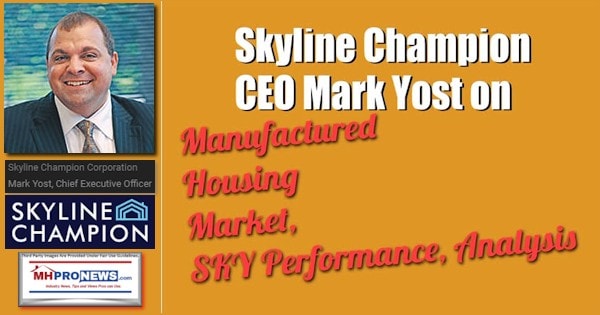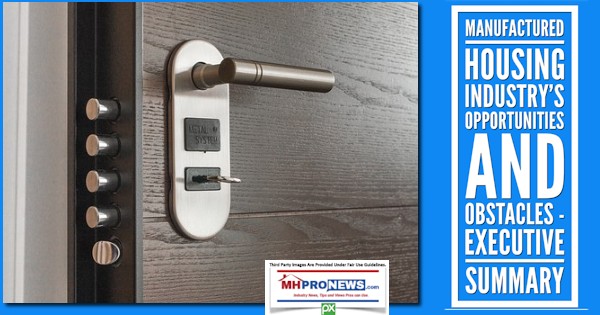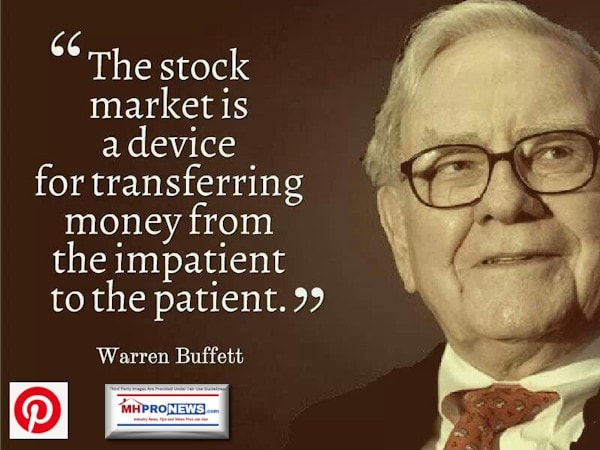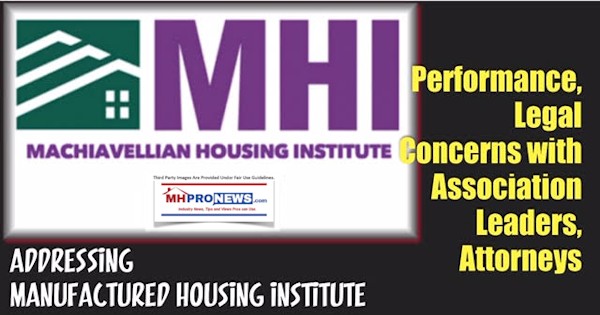
On August 3, 2019 the transcript of the Skyline Champion conference call was published.
Participants in that conference call were reported by Seeking Alpha as follows.
Skyline Champion Corporation (NYSE:SKY) Q2 2019 Earnings Conference Call August 1, 2019 8:00 AM ET
Company Participants
Mark Yost – CEO
Laurie Hough – EVP and CFO
Conference Call Participants
Daniel Moore – CJS Securities
Greg Palm – Craig-Hallum Capital Group
Phil Ng – Jefferies
Matthew Bouley – Barclays
Mike Dahl – RBC Capital Markets
Note that Skyline’s closing ticker for Friday can be found in that evening’s manufactured home industry7 connected stock market report, linked here.
Their SEC 10-Q for the period covered is located at this link here as a download.
In the extensively quoted material from Seeking Alpha that follows, the focus here will be on comments or replies made by Mark Yost, President and Chief Executive Officer (CEO) for Skyline Champion (SKY). It will be followed by some MHProNews analysis and links to additional information. Breaks in the dialogue will be shown like this … as is customary.
…
Mark Yost
Thank you for participating in our earnings call to discuss our first quarter results. Joining me today on today’s call is Laurie Hough, EVP and CFO. I’m excited to be joining you today for my first earnings call as Chief Executive Officer of Skyline Champion, following the retirement of Keith Anderson in June. It is an honor to be leading such a strong organization, and I believe that we have a long runway ahead of us to continue to grow our business and improve our operations while providing our customers with high-quality, innovative and affordable housing solutions.
I’ll start off today’s call with some highlights from our results, then provide updated commentary on the market, discuss some of the progress we’ve made with our operational and growth initiatives, and Laurie will deliver some additional detail on the results. Then we will touch on the outlook.
As a reminder, the combination of Skyline and Champion closed on June 1, 2018, which was during our first quarter of fiscal 2019. Therefore, the results for the first quarter of fiscal 2020 include 3 full months of operations for the combined company Skyline Champion, while our year-ago comparables include 2 months of legacy champion and 1 month of the combined Skyline Champion.
Let me begin by saying that I am pleased to report very solid results, in a quarter where the HUD market was in a period of destocking and the housing market was choppy. During the first quarter, we grew our revenue by 15% year-over-year. We sold 20% more homes in the U.S. at an average selling price of $60,900. We leveraged our top line growth and delivered 38% year-over-year increase in gross profit. Adjusted EBITDA for the quarter was $32.1 million, a 41% increase year-over-year. Adjusted EBITDA margin in the quarter was 8.6%, a 150 basis point improvement compared to the 7.1% a year ago. The strong margin improvement was driven by revenue growth, lower material costs, refinement of our product offerings and operational improvements. Additionally, we continued to realize synergies during the quarter.
Turning to the market. We remain positive on the outlook for the manufactured housing industry, as we see the opportunity for continued growth, driven by both demographic and economic factors. We continue to see underlying demand for our homes, driven by a market still characterized by short supply following a decade of limited home production, especially at affordable price points. Factory-built homes offering a compelling value proposition to consumers that are impacted by affordability issues that place many families out of homeownership, coupled with increases in apartment rental rates. Our homes are a solution to the growing need for sustainable and attainable housing.
Toward the end of the first quarter, the industry experienced improvements in certain U.S. markets as it moved past short-term weather-related slowdowns and higher-than-normal inventory levels at industry retailers. As we mentioned on last quarter’s call, we experienced some demand softening due to retailer inventory destocking in certain markets. We believe that the markets impacted by these conditions have moved past the delivery delays and have stabilized. We remain encouraged about the outlook for the U.S. housing market and the short-term issues that have subsided, and end consumer demand remained and continues to remain healthy.
In Canada, orders were down 43% during the quarter. British Columbia market continued to experience the largest year-over-year decline, and the Alberta region remained weak. In light of the challenging market conditions, our Canadian plants performed well and remained profitable with solid margins due to our efforts to effectively manage production loans and reduce fixed expenses during the slower housing market cycle.
Overall, the backlog for the company fell by 31% year-over-year. This was driven by a 60% decline in Canada and a 28% decrease in the U.S. Canadian backlogs are down due to the challenging market conditions mentioned, while U.S. backlogs were impacted by the retail channel inventory destocking. During the quarter, U.S. retailers worked to reduce their inventory by delivering and setting their on-site inventories. At the end of June, our consolidated backlogs were $153 million compared to backlog last June of $222 million. Year-ago backlog was elevated due to the lingering impact of our FEMA production on core product backlog.
Although backlog varied significantly by plant, our average U.S. plant backlog stood at 6 weeks of production at the end of the quarter. Sequentially, from the March quarter, Canadian backlogs declined 19% while U.S. backlogs grew 9%. Sequential backlog growth is due to orders starting to rebuild following a slower start to the spring selling season.
On the regulatory front, we are encouraged by recent developments. As you may know, during the quarter, Skyline Champion displayed some of our homes on the National Mall, including the new class of homes promoted by the GSEs. The response from the thousands of customers and government officials who toured the homes was overwhelmingly positive. Shortly thereafter, the President signed an executive order, focused on leading regulatory barriers that impede the production of affordable housing. We believe the continued drive from all parts of the government to ultimately provide consumers with increased access to attainable and sustainable homes will help spur demand for manufactured homes.
On the financing front, we continue to educate our customers on the benefits of the MH Advantage and Choice home programs that are part of the GSE’s duty-to-serve programs.
The education process related to these new class of homes is underway, and as expected, will take time. We are very encouraged about the long-term potential of these programs. We have created and are rolling out a separate brand dedicated to this new class of homes, positioned to serve the needs of our retail and builder developer partners. We expect this new class of homes in the GSE channel loan securitization to have a positive impact as we look towards fiscal 2021.
Turning to our expansion efforts. Our Leola, Pennsylvania park model facility began production in April and contributed to profitability by the end of the quarter. Our lease of Louisiana manufacturing facility began production on schedule at the beginning of June. Leesville represents Skyline Champion’s 38th facility and incorporates promising new technology for floor and wall build stations. As we’ve mentioned before, we are initially incorporating this technology into our manufacturing process through a pilot program that we believe will mitigate some of the direct labor risks, while benefiting the bottom line. Through this technology, we are improving the value and quality of our homes’ future homebuyers while also improving the safety and work environment of our employees.
We have an incubator team that is assessing this technology as part of our longer-term strategy to scale automation enhancements at our other facilities. Our Leesville plant is the only MH facility located in the state of Louisiana and is a prime example of our strategic focus to grow production capacity in markets that are in close proximity to our customers while leveraging technology. These efforts are helping to make homeownership more attainable for the broader reach of families.
I will now turn the call over to Laurie to discuss our quarterly financials in more detail…
From Q&A
…
Daniel Moore
Okay. And last thing, and I’ll jump out. Backlog, down year-over-year, but up sequentially in the U.S. Can you just talk about how many weeks of backlog you’re operating at now? How does that compare to historic averages? And what are optimal levels, where would you like to be?
Mark Yost
Yes. So, Dan, right now, we’re operating at about 6 weeks of backlog. Typically, we’d like to operate in the 4 to 6-week range of backlog that allows us to have a timely delivery to our customers, but it also allows us to effectively schedule production and the supply chain with our suppliers. So 4 to 6 range is optimal. I think backlogs last year were elevated due to kind of the lingering effects of the FEMA production. And compared to prior years, 6 weeks is actually above normal, actually. So I think the backlog levels are good, especially given the fact that we’ve increased our productivity year-over-year-over-year. So 6 weeks this year is probably much better than 6 weeks 2 years ago because of the productivity enhancements.
Greg Palm
Congrats on the really good results here. So starting out with unit growth, specifically, let’s talk about U.S., which has trended nicely better than the industry volumes, obviously, implies some market share gains. But just kind of curious, how much of that is a byproduct of the new capacity coming online. Where are you seeing the most strength?
Mark Yost
Yes. I think, overall, we did see our U.S. shipment growth, on a similar basis, go up 3% year-over-year. So we do feel we’re performing very well given the challenging markets. Overall, we’ve seen growth somewhat, to be honest, Greg, across the board. Our park model and mod sales have been up year-over-year. HUD shipments, I’d say, we still had the destocking in the Texas to Tennessee region throughout the quarter. Things have picked up since then. So we’ve kind of seen a normalization. I would say the geographic slowdown in destocking is now kind of behind us. Now what we’re seeing is product specific, plant specific, more normalization of some of the backlogs and some of the product development pipeline. So I think, overall, we’re feeling pretty good across the country just with certain product categories still kind of coming out of the backlog inventory destocking.
Greg Palm
All right. Great. Shifting gears to Leesville. I’m curious, you talked about some of this new technology that you’re incorporating over there. Is that targeting, I guess, better margins for that plant, improved efficiencies and throughput? What’s sort of the end goal? And can you maybe talk a little bit in detail what you’re actually putting in there from a pilot program?
Mark Yost
Yes, sure. So we’re starting off, Greg, with just some very basic technology that will advance over time. So our incubator team that we’ve assembled is kind of working through how to redefine our production processes. So the automation will, one, it will improve quality, so at the end of the day, we’ll have a much cleaner product coming out; two, it will save our material costs, we’ll have less scrap generation and enhancement there. So you’ll get benefits there. On the direct labor side, we’ll save a little bit of direct labor costs, but I would say, I view it more as a future direct labor risk avoidance, direct labor is going to get more challenging, not less challenging in the future. And so in doing this, we can hire a more stable workforce and get up to speed training faster, along with the benefits that we found that the up-and-coming millennials will enjoy working with this technology much more so than maybe prior physical labor. So all those benefits kind of accrue, and we’re going to roll it out and work out the bugs in Leesville and then roll it forward as we learn and discover how to optimize it and step up the curve.
…
Greg Palm
Okay, perfect. And then I guess, just last one. Mark, going back to a comment towards the end of your prepared remarks. You said something like kind of pricing pressure due to destocking. Was that a comment sort of in hindsight, what you’ve seen sort of in the spring and early summer months? Or was that kind of a future comment? Just wanted a clarification, if we could.
Mark Yost
No, I think it’s probably more of a future comment over the next month or 2, let’s say, Greg. Towards the end of the inventory destocking, we saw a handful of the market participants looking to generate or trying to stimulate orders with some pricing, and we have backlogs of 6 to 8 weeks depending on the parts of the country. That pricing came into effect toward the tail end of the quarter. So you’ll just see that kind of rolling through. I don’t think it’s everybody, but you just see a little bit of softness.
…
Phil Ng
Good to hear that the destocking has winded down at the retailer level. Have you seen any restocking activity? And now that you’re lapping some of the tougher FEMA comps, how do you think about the type of shipment growth you’re expecting in the next few quarters?
Mark Yost
Yes. I think it has been good, Phil, to see the destocking kind of getting in the rear view mirror. So that’s been encouraging. I think, overall, we see the next few quarters, I would say that the market itself will be relatively, for the remainder of this calendar year, be somewhat similar to last year, maybe slightly up. And then towards the — going into next year calendar, we’ll see growth. In the marketplace versus last year.
Phil Ng
Okay. So you’re expecting kind of flattish-type growth in the market. But given some of your geography [indiscernible] you’re bringing on, do you expect to continue to kind of outpace the market?
Mark Yost
I think as long as we’re bringing value to our customers in the right ways that we should continue to outpace the market, yes.
Phil Ng
Got you. And then given some of the modest pricing pressure you called out in the channel right now, can you kind of quantify or expand on the magnitude? It didn’t sound like that was that meaningful. The reason why I’m asking, obviously, you benefited from input costs fading a bit. The tariffs, I understand, are coming through, obviously. How impactful could that be in with maybe some more modest pricing? Could we see margin depression the next few quarters?
Mark Yost
I think the question would be with tariffs coming in or maybe slight input costs increasing, you’ll probably be a little delayed in passing through some of those price increases for a month or 2. So I do think there could be a little bit of compression as you go, just to normalize the market. But I think with backlogs building — like I said, our backlog has built 9% in the U.S. year-over-year. So as backlogs continue to build, I think we’ll see the market kind of normalize that. I think it was just towards the tail end of the short-term downturn due to the destocking.
Phil Ng
Got it. And just one last one from me. I think, Laura, you mentioned now that integration of Skyline behind you, and obviously, your balance sheet is very solid, you mentioned potentially taking a more proactive stance on capital deployment. Curious, from an organic standpoint, where is your capacity kind of shaping up across some of these major regions. Are there any pockets where you think ramp up more capacity? And then when you think about M&A, should we expect bolt-ons to be a meaningful driver going forward? And any way to kind of think about valuation? Understand there’s a few M&A — some M&A activity lately in the industry.
Mark Yost
Sure. I think, overall, we’re always looking at M&A activity. I think, both in the consolidation of the industry to expand economies of scale and lower the costs overall to the end consumer, I think there’s some opportunities in certain geographies. I think we see strong market demand. When you look at end consumer demand and the placement levels that we see in staff survey and other third-party services, the end market is still growing quite healthily, especially in certain regions of the country. So I think we would be interested in continuing to grow, especially with the backdrop of the financing returning and the new class of homes and the expansion of that into both the retail channel and also into the larger home building market with builder developers.
So I think both of those opportunities, to expand capacity and with further M&A or organic startups, is an opportunity. And I think, overall, we probably look to make ourselves better to do business with for our customers. So looking at opportunities and pain points for our customers in the retail channel and in the builder developer channel that if there’s acquisitions or investments we could make to solve communication or development or other channels for them, interested in doing those activities as well.
…
Matthew Bouley
I wanted to follow up on the Leesville plant. You mentioned that it is a pilot program and that you’ve got this incubator team. Just what’s the timeline for evaluating that? And I guess, Mark, over time, just how do you envision ultimately bringing these processes to additional facilities?
Mark Yost
Sure. Sure, Matt. I think, overall, the plant just started up in June. So I think we’re kind of in the midst of the learning curve. So we’re learning quickly, which is a great thing. I would expect that different pieces of this could be rolled out relatively quickly in the next year or so to other facilities. Some of the things like the larger wall building technology and changing some of the production flow processes that we would need to do, probably a little bit longer term, probably in the 2- to 3-year horizon. So it really just depends on which piece of automation. We have 3 or 4 different processes ongoing at that plant. And they’re all kind of in that incubator stage.
Matthew Bouley
Okay, perfect. And then I think last quarter, you guys talked about April orders, up double digits. Any color on order trends through the quarter and into July?
Mark Yost
Sure. I think order trends overall, April was strong, May was down, June was strong. So I’d say, overall, for the quarter, our orders were up year-over-year on a same basis, 1% to 2%. And so I think as we see the trend forward, we’re going to continue to see the backlog strengthen between now and September, October and then our typical normal winter slowdown.
…
Mike Dahl
Mark, I wanted to follow up on the comments around orders just now. I guess, if I take your commentary about moving past the inventory issues, it would seem like at retail, the retailers would have some room on the forefront plan of credit lines again, but you’re still seeing the destocking. With consumer demand strong, just wanted to get your views on why you don’t think there’s been a quicker ramp back up in order activity from the retailers? And what are kind of the impeding factors here?
Mark Yost
Yes. Thanks, Mike. I think the way we see it and the way it normally works is when backlogs are long in duration, so we have larger backlogs, normally, orders will pull forward in the cycle, meaning that they will place orders earlier. And when backlogs are low, you’ll see orders come in at the last minute. So I think the order level can be a little bit of a misread. In terms of the fact that when backlogs are light, people will delay their orders to the last minute to get them in the pipeline. So on an equivalent basis, I think you’ve really got to take the shorter-term backlogs in conjunction with the order rates. I think they kind of go hand in hand because you won’t see strong orders until the last minute, which will probably start coming in towards — in the second quarter time period.
Mike Dahl
Okay. So while your expectations are that the market is still relatively flat in the second half, it seems like some of that’s also just probably prudent conservatism based on what you’ve just seen, and there’s some potential for a better uptick from those last-minute orders?
Mark Yost
Sure. I mean, that’s fair.
…
Mike Dahl
Okay, great. That’s helpful. And also a nice level if you can continue there. And then my last question, just around the comments on the product refinement. I just wanted to dig in a little bit more on that and figure out kind of how much of that is some of the forward plan and SKU rationalization versus other mix issues or intentional shifts there. Can you just give us a little more detail on when you say that product refinement was a benefit, what specifically are you talking about?
Mark Yost
Yes. I think it’s more the SKU and forward plan and other factor refinement to where we are getting ahead of the design curve, allowing us to bring in predesign flexibility to give more optionality for our customers, but at the same time, optimize our manufacturing processes. So I think it’s that combination along with the product standardization and SKU rationalization that has helped us to optimize some of that product refinement.
…
##
The entire SKY conference call transcript is found on Seeking Alpha at this link here.

MHProNews Analysis and Commentary
There are a variety of reasons why people say or do whatever. Statements by anyone from any organization of any kind, for example, may be made out of:
· Conviction
· Ignorance,
· Deception,
or a mix of such factors.
It is not the intention in this analysis to speculate about the state of mind of Skyline Champion’s CEO Mark Yost when making the statements that he did.
That said, there are several striking things about this narrative for those who are close readers of MHProNews. For example.
While there is obvious mention of the potential for the new manufactured home market during an affordable housing crisis, and SKY Investor Relations packages routinely show that the industry is underperforming, there is scant discussion on this question. Why isn’t more of the public turning to manufactured housing in far greater numbers?

Or where is the discussion of why the Government Sponsored Enterprises (GSEs) of Fannie Mae and Freddie Mac aren’t doing robust lending on all of manufactured housing, instead of the emphasis on the so-called ‘new class of homes’ promoted by Clayton Homes and MHI?
Where is the discussion of zoning, placement, or other such controversies?
The new class of homes topics ought to raise several concerns that won’t be the focus for this analysis – but will be mentioned as a placeholder for a future report.
Finally, there ought to be some concern about sourcing of information with respect to publicly traded firms operating in the manufactured housing industry.

The related reports linked below should be closely studied in connection with this commentary on the SKY quarterly statements.

To shake things up and lighten the mood for the start of the work week, let’s post The Mamas and the Papas singing their 1966 hit. This version has had over 31 million views on YouTube.
That’s this ‘Monday, Monday’ installment of “News through the lens of manufactured homes and factory-built housing” © where “We Provide, You Decide.” © ## (News, analysis, and commentary.)

Soheyla is a managing member of LifeStyle Factory Homes, LLC, the parent company to MHProNews, and MHLivingNews.com.
Connect with us on LinkedIn here and here.
Related Reports:
Click the image/text box below to access relevant, related information.






























